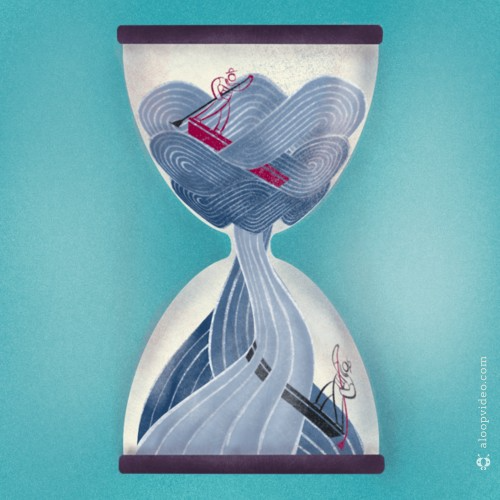In the Quantum Realm, Not Even Time Flows as You Might Expect
New study shows the boundary between time moving forward and backward may blur in quantum mechanics.

Artistic illustration of a gondolier trapped in a quantum superposition of time flows.
Image credit: Aloop Visual and Science, University of Vienna
New study shows the boundary between time moving forward and backward may blur in quantum mechanics.
A team of physicists at the Universities of Bristol, Vienna, the Balearic Islands and the Institute for Quantum Optics and Quantum Information (IQOQI-Vienna) has shown how quantum systems can simultaneously evolve along two opposite time arrows - both forward and backward in time.
The study, published in the latest issue of Communications Physics, necessitates a rethink of how the flow of time is understood and represented in contexts where quantum laws play a crucial role.
For centuries, philosophers and physicists have been pondering the existence of time. Yet, in the classical world, our experience seems to extinguish any doubt that time exists and goes on. Indeed, in nature, processes tend to evolve spontaneously from states with less disorder to states with more disorder and this propensity can be used to identify an arrow of time. In physics, this is described in terms of ‘entropy’, which is the physical quantity defining the amount of disorder in a system.
Dr Giulia Rubino from the University of Bristol’s Quantum Engineering Technology Labs (QET labs) and lead-author of the publication, said: “If a phenomenon produces a large amount of entropy, observing its time-reversal is so improbable as to become essentially impossible. However, when the entropy produced is small enough, there is a non-negligible probability of seeing the time-reversal of a phenomenon occur naturally.
“We can take the sequence of things we do in our morning routine as an example. If we were shown our toothpaste moving from the toothbrush back into its tube, we would be in no doubt it was a rewinded recording of our day. However, if we squeezed the tube gently so only a small part of the toothpaste came out, it would not be so unlikely to observe it re-entering the tube, sucked in by the tube’s decompression.”
The authors of the study, under the lead of Professor Caslav Brukner of the University of Vienna and the IQOQI-Vienna, applied this idea to the quantum realm, one of whose peculiarities is the principle of quantum superposition, according to which if two states of a quantum system are both possible, then that system can also be in both states at the same time.
Dr Rubino said: “Extending this principle to time’s arrows, it results that quantum systems evolving in one or the other temporal direction (the toothpaste coming out of or going back into the tube), can also find themselves evolving simultaneously along both temporal directions.
“Although this idea seems rather nonsensical when applied to our day-to-day experience, at its most fundamental level, the laws of the universe are based on quantum-mechanical principles. This begs the question of why we never encounter these superpositions of time flows in nature."
Dr Gonzalo Manzano, co-author from the University of the Balearic Islands, said: “In our work, we quantified the entropy produced by a system evolving in quantum superposition of processes with opposite time arrows. We found this most often results in projecting the system onto a well-defined time’s direction, corresponding to the most likely process of the two. And yet, when small amounts of entropy are involved (for instance, when there is so little toothpaste spilled that one could see it being reabsorbed into the tube), then one can physically observe the consequences of the system having evolved along the forward and backward temporal directions at the same time.”
Aside from the fundamental feature that time itself might not be well-defined, the work also has practical implications in quantum thermodynamics. Placing a quantum system in a superposition of alternative time’s arrows could offer advantages in the performance of thermal machines and refrigerators.
Dr Rubino said: “Although time is often treated as a continuously increasing parameter, our study shows the laws governing its flow in quantum mechanical contexts are much more complex. This may suggest that we need to rethink the way we represent this quantity in all those contexts where quantum laws play a crucial role.”
Publication: Giulia Rubino, et al., Quantum superposition of thermodynamic evolutions with opposing time’s arrows, Communications Physics (2023). DOI: 10.1038/s42005-021-00759-1.
Original Story Source: University of Bristol

 Alerts Sign-up
Alerts Sign-up